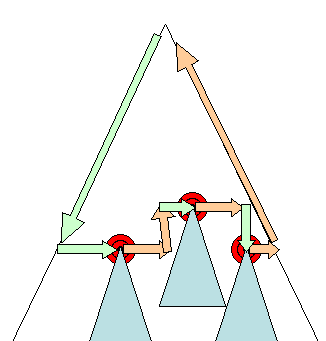Layout
When the renderer is created and added to the tree, it does not have a position and size. Calculating these values is called layout or reflow.
HTML uses a flow based layout model, meaning that most of the time it is possible to compute the geometry in a single pass. Elements later ``in the flow'' typically do not affect the geometry of elements that are earlier ``in the flow'', so layout can proceed left-to-right, top-to-bottom through the document. There are exceptions - for example, HTML tables may require more than one pass (3.5).
The coordinate system is relative to the root frame. Top and left coordinates are used.
Layout is a recursive process. It begins at the root renderer, which corresponds to the element of the HTML document. Layout continues recursively through some or all of the frame hierarchy, computing geometric information for each renderer that requires it.
The position of the root renderer is 0,0 and its dimensions is the viewport - the visible part of the browser window.
All renderers have a "layout" or "reflow" method, each renderer invokes the layout method of its children that need layout.
Dirty bit system
In order not to do a full layout for every small change, browser use a "dirty bit" system. A renderer that is changed or added marks itself and its children as "dirty" - needing layout.
There are two flags - "dirty" and "children are dirty". Children are dirty means that although the renderer itself may be ok, it has at least one child that needs a layout.
Global and incremental layout
Layout can be triggered on the entire render tree - this is "global" layout. This can happen as a result of:
- A global style change that affects all renderers, like a font size change.
- As a result of a screen being resized
Layout can be incremental, only the dirty renderers will be layed out (this can cause some damage which will require extra layouts).
Incremental layout is triggered (asynchronously) when renderers are dirty. For example when new renderers are appended to the render tree after extra content came from the network and was added to the DOM tree.
Asynchronous and Synchronous layout
Incremental layout is done asynchronously. Firefox queues "reflow commands" for incremental layouts and a scheduler triggers batch execution of these commands. Webkit also has a timer that executes an incremental layout - the tree is traversed and "dirty" renderers are layout out.
Scripts asking for style information, like "offsightHeight" can trigger incremental layout synchronously.
Global layout will usually be triggered synchronously.
Sometimes layout is triggered as a callback after an initial layout because some attributes , like the scrolling position changed.
Optimizations
When a layout is triggered by a "resize" or a change in the renderer position(and not size), the renders sizes are taken from a cache and not recalculated..
In some cases - only a sub tree is modified and layout does not start from the root. This can happen in cases where the change is local and does not affect its surroundings - like text inserted into text fields (otherwise every keystroke would have triggered a layout starting from the root).
The layout process
The layout usually has the following pattern:
- Parent renderer determines its own width.
- Parent goes over children and:
- Place the child renderer (sets its x and y).
- Calls child layout if needed(they are dirty or we are in a global layout or some other reason) - this calculates the child's height.
- Parent uses children accumulative heights and the heights of the margins and paddings to set it own height - this will be used by the parent renderer's parent.
- Sets its dirty bit to false.
Firefox uses a "state" object(nsHTMLReflowState) as a parameter to layout (termed "reflow"). Among others the state includes the parents width.
The output of Firefox layout is a "metrics" object(nsHTMLReflowMetrics). It will contain the renderer computed height.
Width calculation
The renderer's width is calculated using the container block's width , the renderer's style "width" property, the margins and borders.
For example the width of the following div:
<div style="width:30%"/>
Would be calculated by Webkit as following(class RenderBox method calcWidth):
- The container width is the maximum of the containers availableWidth and 0. The availableWidth in this case is the contentWidth which is calculated as:
clientWidth() - paddingLeft() - paddingRight()
clientWidth and clientHeight represent the interior of an object excluding border and scrollbar. - The elements width is the "width" style attribute. It will be calculated as an absolute value by computing the percentage of the container width.
- The horizontal borders and paddings are now added.
So far this was the calculation of the "preferred width". Now the minimum and maximum widths will be calculated.
If the preferred width is higher then the maximum width - the maximum width is used. If it is lower then the minimum width (the smallest unbreakable unit) hen the minimum width is used.
The values are cached, in case a layout is needed but the width does not change.
http://taligarsiel.com/Projects/howbrowserswork1.htm#Layout
